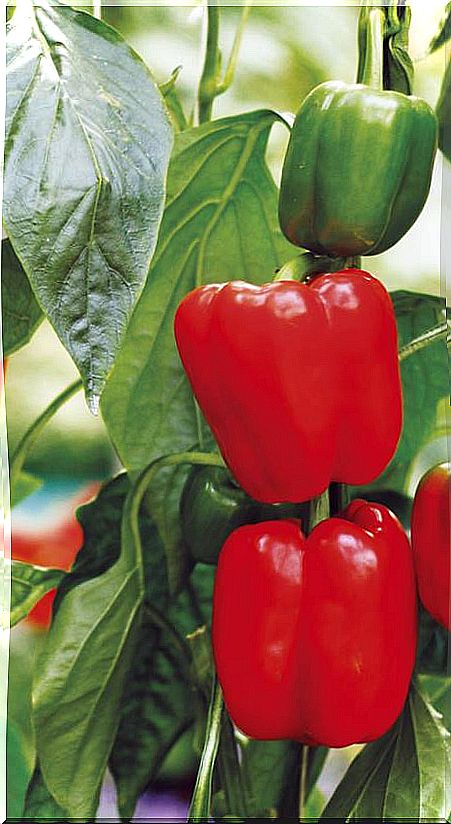Orchard Calendar: What To Plant And Collect In August
The sun and heat give a great boost to the harvests of our garden in August if we control the irrigation times well and use balanced fertilizers.

- What to plant in August
- Put basil on your balcony
- What crops can we harvest in August
- Summer wonder lettuce, the queen in August
- The tasks of the garden in August
- Irrigation: less water to enhance flavor
- How to fertilize and prevent pests
- Control spider mite attacks
In the middle of August, just as our skin suffers from the intense solar radiation typical of summer, most of the plants we grow also suffer from the intense heat and radiation of the sun ; even those plants that love it, such as tomato plants, peppers or aubergines.
Solar radiation weakens the immune system of plants and promotes virus attacks, and the appearance of numerous parasites and diseases. We can help them protect themselves from the sun in the hottest months, placing a green mesh shading that filters the intensity of the sun’s rays.
For extra protection against the sun, at the end of this article I will also tell you how to make a “sunscreen” for your plants.
What to plant in August
In hot weather we can also sow plants, in many cases in order to prepare the autumn crops. These are some of the most prominent:
- Mixture of tender leaves: We can sow thickly, in a planter or a large pot, a large selection of leafy vegetable seeds: various kinds of lettuce, chard, spinach, endives, arugula, lamb’s lettuce and Chinese cabbages … Then we will cut the very tender leaves.
- Leeks: It is the ideal time to sow and transplant leeks, since they develop best in the autumn winter and early spring months and are very slow developing plants. That is why it is convenient that we anticipate and begin with its sowings and transplants.
- Borage: Outside of Aragon its consumption is not very widespread, but borage is very rich in inulin and prebiotic substances, so we are interested in growing them in our garden. We are in the best time to carry out its sowing and transplants.
- Romanesco cabbage : Halfway between cauliflower and broccoli, romanesque cabbages develop their best heads in the fall and winter, so we should start making the seedlings, having seedlings to transplant at the end of September.
Put basil on your balcony
Basil is an aromatic, culinary and medicinal plant that stands out for its protective properties of nearby crops and that stimulates the quality and production of other plants. When growing it, it must be taken into account that:
- It is a lover of light and heat, so you have to look for the sunniest and warmest spaces on the balcony or terrace.
- We will cultivate it with a good substrate, to which we will add from time to time or a little worm castings.
- We must not neglect to water them regularly.
We can consume its fresh leaves in salad, in stews or to make an excellent pesto sauce. To cut it, it is convenient to cut the branches just when they begin to bloom ; This way, new shoots will emerge and we will be able to continue “harvesting” leaves and shoots until the intense cold arrives.
What crops can we harvest in August
It is time to harvest courgettes, aubergines, cucumbers, young beans, tomatoes, lettuces … In order to make the most of the fruits of the garden, it is advisable to take into account some useful tips at harvest time. We will highlight some of the crops that we can harvest in August, with tips for each one:
- Peppers 4 songs: To enjoy the large peppers of the variety four songs or similar, we will have had to wait for the arrival of the intense heat. They concentrate more nutrients when we harvest them when they are already totally red.
- Carrots: The carrots that we sow in spring will be in their maximum splendor, if we harvest the thickest and most well-formed ones, those that are small will still have time to thicken until the cold autumn season arrives.
- Red beet: It is convenient to wait until they have thickened to the maximum to harvest them, but if we see that with the heat some tend to glean we can remove them. We will thus leave more space for the rest and take advantage of the fact that they have not yet become fibrous.
- Dried beans: Dried beans or kidney beans are those tender beans that the marines let mature in the bush. The hardened grains are harvested in full sun and then shelled from the pods. We can cook them as dry beans or save them for planting.
- Zucchini: Harvest the zucchini frequently and rather tender, since if we let them get too fat, the bush will stop producing new zucchini.
- Young beans and tomatoes: We will harvest them in the good morning, which is when they are fresher and smoother. When the sun and heat are strong, they tend to wilt easily.
- Lettuces: If we have few lettuces in our pot or home garden, every day we can harvest some of the outermost leaves of each of the available lettuces, and we will see that new leaves will continue to grow from the inside for future harvests.
If we do not have much space in the refrigerator to keep the vegetables harvested each day cold, we can place a damp cloth on the basket or box where we store the harvest. As the water evaporates with the heat, the inside of the container cools and keeps them cool.
Summer wonder lettuce, the queen in August
Among the lettuces, the summer wonder lettuce deserves special mention in August. It is a variety of dark buds and green leaves, sweet and crunchy. The name comes from its great resistance to summer heats and for being the variety of lettuce that takes the longest to glean and mount in flower, considerably lengthening the harvest period.
It is easy to reproduce by sowing its small seeds in any container with substrate and moisture. Then we have to transplant to the ground, in a pot or a cultivation table with a good substrate enriched with worm humus.
A semi-shaded place and regular and copious waterings are good for them.
If we have few bushes, from which the leaves are well formed, we can harvest the outer ones for salad, while the inner ones will form a large bud.
The tasks of the garden in August
The heat and the sun create a demanding environment for the plants in our garden and this marks the most important tasks that we should not neglect in the month of August.
Irrigation: less water to enhance flavor
Often times, as a precaution in summer, we choose to water more than is convenient so that the plants do not suffer from water stress and that they are more productive. However, overwatering causes the plants to be more tender and weakened, and they are more prone to getting sick and being attacked by parasites, fungi or rot that can ruin everything.
In addition, excess watering increases the water content in the plant, and this means less flavor and less sweetness than when the plants go through some thirst from time to time.
If we want to increase the flavor and the concentration of nutrients of our cultivated plants, it is convenient to restrict the time or the amount of irrigation water from time to time, but maintaining the periodicity.
Why? Because if many days pass from one watering to the next, the leaves and fruits tend to harden. Then, when they swell suddenly when they receive plenty of water, they greedily absorb it and cracks appear that cause them to spoil easily.
How to fertilize and prevent pests
There are granites and colored bars with synthetic fertilizers that are marketed to accelerate the development of crops and increase the production of garden crops. They are made from soluble minerals and nitrogen. However, in practice, they cause large nutritional imbalances and lead to the appearance of numerous parasites, pests and diseases that seriously harm or damage our crops.
In organic farming, the use of synthetic fertilizers is not allowed and it is chosen to feed the cultivated plants in a natural and balanced way through regular contributions of organic matter and compost, more or less decomposed depending on the cultivated plants and their state of development.
We have a better option within our reach to keep the plants well nourished and increase the production of demanding summer crops, such as tomato plants, aubergines, peppers, zucchini or cucumbers. It is about watering them once a week (or every 15 days) with water where we will have previously diluted a few handfuls of worm humus, leaving it to marinate for a few hours.
In the worm humus are all the nutrients in a balanced way and they absorb it easily, developing very healthy and increasing its production without producing imbalances.
Control spider mite attacks
With the intense summer heat, in orchards where bare soil is worked, or on cultivation tables where the substrate dries up, problems of uncontrolled spider mite attacks often appear, which often end up drying the leaves of crops such as tomato plants or bean bushes.
The organic straw or padded avoid the heat rising from the parched earth and prevent the development of tiny spider mite.
If we do not have padding, it is important that we can regularly maintain moisture in the soil and the base of the plants.
We will carry out more frequent waterings and we can even sulfate soap and water at dusk, wetting the lower leaves of tomato plants and beans well. We will try to soak the lower part of the leaves, which is where spider mites usually nest.
Conserve summer surpluses
In the hottest months, everything grows very fast and the harvests accelerate. There is so much abundance and production that, even if we have a slightly loose garden, we often do not know what to do with the kilos and kilos of tomatoes, peppers, courgettes or aubergines that the plants give us.
It is a very good time, therefore, to make preserves or make surpluses and so we will fill the pantry for winter:
- Having a solar (or electric) dryer allows us to dehydrate most vegetables in slices, facilitating their prolonged conservation in airtight glass jars or under vacuum.
- Canned in the bath (in recycled glass jars) remains one of the traditional and easier for home canning systems.
How to make a “sunscreen” for your plants
In addition to putting green nets that provide shade to protect the crops from the sun, we can apply a treatment as a “sun protection cream”. It involves spraying them at sunset with a dilution of sun-resistant plants in water. This is the recipe and the instructions to apply it:
- Use a large piece of aloe vera (with skin), two or three leaves of aloe arborescens, or a few sprigs of sediform sedum.
- Grind them well in a liter of water and let them marinate for a few minutes.
- Filter and, with this “sunscreen” liquid, thoroughly wet the leaves at sunset, once a week or every 15 days.









